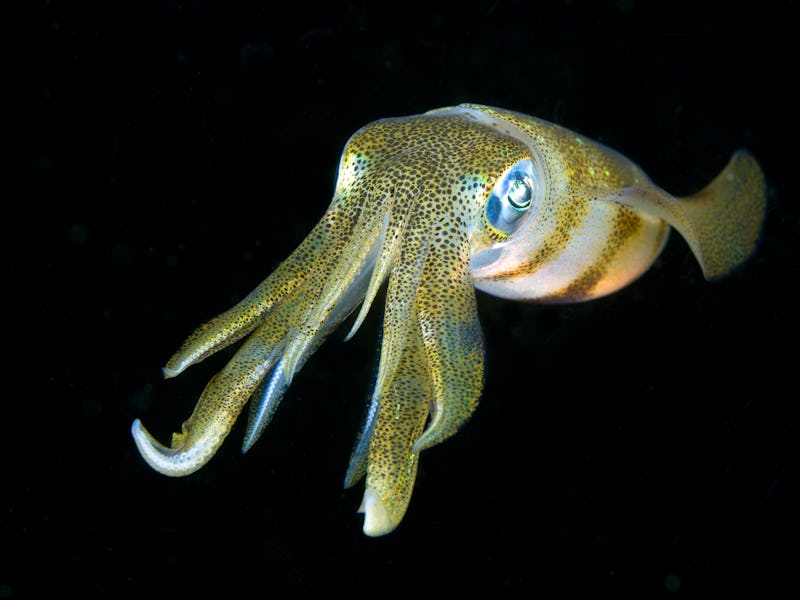First squid MRI study shows brain complexity similar to dogs
Researchers put a squid in an MRI to study its neural networks. The resulting snapshots are stunning.

With their peculiar movement, deep-sea habitat, and surprisingly huge genomes, squid have fascinated humans for centuries. And now, for the first time, scientists have put the cephalopods in an MRI to get a better look at their brains — revealing that they are much more like another animal beloved to humans than we realized.
That's right: Your calamari has a brain just about as complex as a dog.
Scientists used an MRI machine to get a good look at the brain of a juvenile reef squid. They were able to identify 145 previously unknown pathways and connections, which could help unravel the mystery behind a nifty squid skill — camouflage.
It is a big step toward building a complete guide to the squid brain’s complex neural connections — known as a connectome map — the researchers say.
"This the first time modern technology has been used to explore the brain of this amazing animal,” Chung said in a statement.
Image showing the optic lobe and basal lobe connections in a squid's brain.
The study, led by researchers Wen-Sung Chung and Justin Marshall from the University of Queensland, was published this month in the journal iScience.
Clever cephalopods
Chung explained that cephalopods — the family group that include squid and octopus — have “famously complex brains, approaching that of a dog and surpassing mice and rats, at least in neuronal number.”
Some cephalopods have more than 500 million neurons — about the same as dogs, which clock in around 530 million. Rats have just 200 million. Humans, meanwhile, are blessed with somewhere around 100 billion neurons — but don't let that go to your head. Millions of neurons don't always add up to the same skillset — like changing your body color at will.
The brain power of squids like Sepioteuthis lessoniana, the species imaged in the study, is one of the reasons they’re able to change color on cue. Ironically, squids are colorblind — so they’re sadly not too adept at observing their bodies change color. But the skill is among the traits that make squid so cool — like their ability to count and solve problems.
Squid head (A), brain and eyes (B), brain image (C), brain sections isolated (D–F), brain volume and percentage of each lobe (G), allometric analysis of the lobe complex (H).
"We can see that a lot of neural circuits are dedicated to camouflage and visual communication,” Chung said. That gives squid a “unique ability” to hide from predators, hunt, and communicate with one another.
But to do the study at all, researchers first had to get the squid in the MRI machine — something that required them first fixing the (dead) squid and then preserving their tissue for examination.
Once in the machine, the researchers were able to image their brain in detail. They also took samples of the squids' brains and performed different analyses to help trace a comprehensive picture of their neural connections.
Future directions
From the data, the researchers may be able to get more specific information on some of the squid's characteristics, like figuring out why squid show a certain color at a given time. For instance, a squid might change the color of its body if a predator is nearby, to blend into its surroundings. But if it’s being scoped out from above, the cephalopod may only change its head color.
"Our findings will hopefully provide evidence to help us understand why these fascinating creatures display such diverse behaviour and very different interactions," Chung said.
The new research marks another first for cephalopod studies, following a recent study that decoded the genome of a giant squid. As Inverse reported at the time, the research revealed that the giant squid’s genetic complexity is closing in on that of a human. Giant squid have about 2.7 billion DNA base pairs in their genome, it turns out, while humans have about 3 billion base pairs.
Understanding the brain mechanics behind how squid behave can better allow scientists to make predictions about the history of cephalopods — like when they first evolved to have these adaptations, and what other incredible skills they could be hiding.
Abstract: Using high-resolution diffusion magnetic resonance imaging (dMRI) and a suite of old and new staining techniques, the beginnings of a multi-scale connectome map of the squid brain is erected. The first of its kind for a cephalopod, this includes the confirmation of 281 known connections with the addition of 145 previously undescribed pathways. These and other features suggest a suite of functional attributes, including (1) retinotopic organization through the optic lobes and into other brain areas well beyond that previously recognized, (2) a level of complexity and sub-division in the basal lobe supporting ideas of convergence with the vertebrate basal ganglia, and (3) differential lobe-dependent growth rates that mirror complexity and transitions in ontogeny.